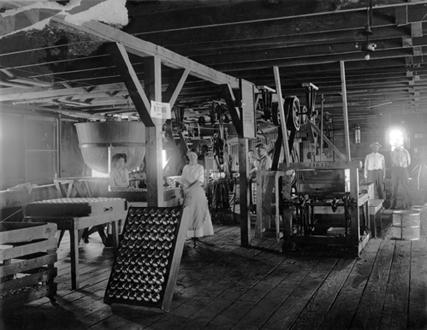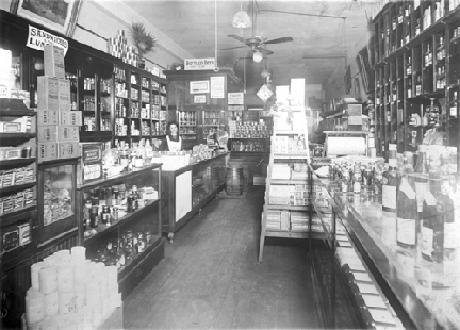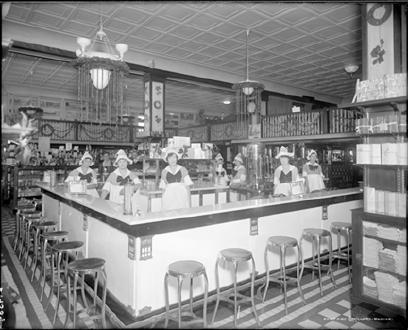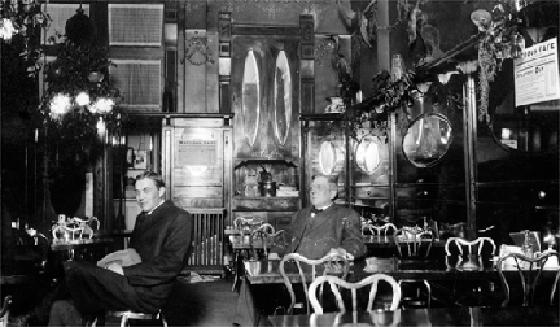Food
What do these photos tell you about the food people ate?
A Food Canning Factory
This photo was taken in a food canning factory. The woman is standing beside a rack of cans. The photo was taken about the year 1900.

Photo: Colorado Historical Society
More About This Topic
People who lived in cities raised very little of their own food. They went to a General Store to buy food in cans. The food was processed at canning factories located in Longmont and other towns along the Front Range. The cities of Colorado provided farmers with a market for vegetables and other farm produce.
Their Own Words
“In 1890 there were relatively few packaged or canned items on the grocer’s shelves. One variety of each was the general rule. Grandma took what she could get. Distribution was pretty strictly local; she bought the kind of groceries her neighbors chose to produce. It was up to grandmother to turn these basic products into appetizing dishes over the coal range.” “She ground her own coffee; laboriously measured the ingredients for puddings, pancakes, and pies; canned or dried all fruits and vegetables; made catsup chili sauce, jellies, and jams; baked her bread and beans; rendered her lard and made her soap. . . . Practically everything was stored in bins and barrels.”
Source: Marguerite Frink Counter, “Pioneer Canning Industry in Colorado,” Colorado Magazine, 30 (January 1953): 38.
A General Store
This is a photo of Leikauf's Meat Market in Denver. The display cases on the left hold beef roasts, pork chops, sliced bacon, and other cuts of meat. Animal carcasses and strips of dried meat are hanging on the wall on the right.

Photo: Denver Public Library, Western History Collection
More About This Topic
People living in cities went to the meat market to buy meat. Most of the meat sold there was fresh. The pigs, chickens, and cows were killed by a local butcher. He cut up the meat and sold it to the city's meat markets. As the meat markets had no refrigeration, they had to sell the meat within a few days.
Their Own Words
"[At Stoddard's Meat Market] there was a great, round “chopping block,” at least 18 inches thick and three or four feet across, which must have been a section of an enormous tree. Much of the meat was in the form of “quarters.” Some hung from hooks in the ceiling and often several would be hung outside to advertise the business…. For 5 cents one could get a really good soup bone that would make the base of a soup that would serve the four of us. For 15 cents one could get enough meat for the main meal."
Source: Quantrille D. McClung, Memoirs of My Childhood and Youth in North Denver (Denver: Colorado Genealogical Society, 1979): 13.
A Lunch Counter
This photo was taken at a lunch counter located in a Denver drug store. The lunch counter was called the Dutch Mill Restaurant. The waitresses are dressed in Dutch-style outfits. The photo was taken about the year 1915. You can tell what season of the year it was taken by looking closely at the photo.

Photo: Denver Public Library, Western History Collection
More About This Topic
People in a hurry ate at lunch counters like the one in the photo. They were the cheap "fast food" outlets of their time. Soups, sandwiches, and desserts were their specialty.
Their Own Words
"It was reported that Denver in 1890 served the cheapest meals, for the food put out, in the United States. Steak, French fried potatoes, bread and butter, coffee and a dessert, raisin pie or bread pudding, was 15 cents."
Source: “Colorado Eats,” WPA Files, Box 5 Denver Public Library
The Watrous Cafe
This is the interior of George F. Watrous's cafe in Denver. It was furnished with long wooden tables. The dining room was decorated with mirrors on the walls.

Photo: Denver Public Library, Western History Collection
More About This Topic
Business people, shoppers, and tourists visiting Colorado's cities ate in cafes or restaurants like this one.
Their Own Words
"Soup: Beaver Tail, St. Julien, Oyster
Fish: Baked Specked Trout, Fried Yampa River Grayling
Boiled: Sugar Cured Ham, Chicken, Elk Tongue with Horseradish
Roast: Loin of Elk, Chili Sauce, Leg of Venison, Mallard Duck, Oyster Dressing
Entrees: Rocky Mountain Elk Steaks, Hunters Style; Elk Brains on Toast; Strawberry Flummery, Cream Sauce; Mayonnaise, Salmon Salad, Pickled Beets." "Relishes: Hartford Sauce, Home Made Catsup, French Mustard
Vegetables: Baked Sweet Potatoes, Scalloped Tomatoes, Sugar Corn, Mexican Beans
Pastry: English Plum Pudding, Mince Pie, White Cake, Gold Cake, California Peaches, Crackers, Nuts, Tea, Coffee, Milk Chocolate."
Source: "First Christmas in Routt County," Steamboat Springs, 1885, CWA Interviews, Doc. 358/22a, Colorado Historical Society.

